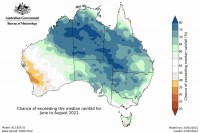Warmer winter ahead for most of Australia
27/05/2021

Most Australians are in for a warmer than average winter, according to the latest seasonal outlook released today by the Bureau of Meteorology.
The Winter Climate Outlook shows night-time temperatures will be warmer than average for the majority of the country. Coastal areas in particular could experience days which are warmer than average.
Although winter is the dry season in Northern Australia it could have more rain than usual over the coming months, while parts of southern Australia could be drier than average.
Bureau Climatologist, Dr Lynette Bettio, said this was consistent with observations from the past 20 years, which show a trend towards drier than average conditions in Australia's south during autumn and early winter.
"Our climate drivers are currently neutral, meaning we're not getting El Niño or La Niña bringing particularly dry nor particularly wet conditions to the continent," Dr Bettio said.
"Warmer ocean temperatures to the north of Australia may increase the moisture available, enhancing rainfall and resulting in a wetter than average dry season across much of northern Australia but as it is dry season, rainfall totals will not be high
Autumn has been wetter than average for certain parts of the country, including for most of New South Wales, southern Queensland and coastal Western Australia.
"New South Wales had its second wettest March on record, with the extreme rainfall and severe flooding late in the month," Dr Bettio said.
"While some areas of Victoria and South Australia have missed out on their usual autumn rainfall and could be heading into a dry winter."
It was the coolest autumn for most of Australia since 2015.
"Cool conditions would have been felt particularly keenly by residents in inland New South Wales, who recorded minimum temperatures one to two degrees below average," Dr Bettio said.
To determine above and below average the observed data is compared to data for the 1961-1990 period. This period is recognised by the World Meteorological Organization as suitable for assessing long-term climate variability and change.
The latest outlooks are available on the Bureau's website.
A Video News Release is available for download here: https://wetransfer.com/downloads/991e1b0087146570a1ffc2def7de538320210526050759/82107d?utm_source=media-release&utm_medium=email&utm_campaign=public-safety










